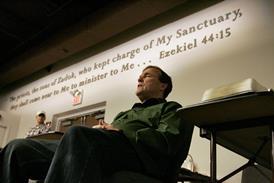‘For veracity and integrity it’s important to know that there are far more original manuscripts for the Bible than for many approved works by contemporary Greco-Roman authors,’ says Jenny Sanders.

Imagine discovering that the 400-year-old Bible you picked up at a thrift festival was worth not the £40 you paid for it, but £10,000! That’s what happened recently to someone called Kerry Eaton from Darlington, who inherited the copy from the friend she originally bought it for. It was a ‘She Bible’. Only a handful still exist, including ones held by Oxford and Cambridge universities as well as Salisbury, Exeter and Durham cathedrals.
The value of this particular edition of the 1611 King James Bible comes from the addition of a single letter in a verse in Ruth 3
The value of this particular edition of the 1611 King James Bible comes from the addition of a single letter in a verse in Ruth 3. Rather than reading ‘he went into the city’, referring to Boaz, verse 15 reads, ‘she went into the city’, referring to Ruth, which probably makes more sense. (’Also he said, Bring the vail that thou hast upon thee, and hold it. And when she held it, he measured six measures of barley, and laid it on her: and she went into the city.’ Ruth 3:15 KJV)
The discrepancy has been put down to a type-setting error and/or ‘ambiguity in the the context of the passage and in the use of different Hebrew manuscripts used for translation.’ How often does this happen, and is it important?
READ MORE: Science catching up with the Bible
Originally written in ancient Hebrew, Greek and Aramaic, these languages typicall did not use lower case letters, spaces or vowels; so deciphering the texts is extremely challenging. However, for veracity and integrity it’s important to know that there are far more original manuscripts for the Bible than for many approved works by contemporary Greco-Roman authors.
In AD 325, the Emperor Constantine and a group of bishops met at the Council of Nicaea, where they approved the canon of Scripture we’re familiar with, 39 books in the Old Testament and 27 in the New. Their decision was confirmed by the Council of Rome in AD 382.
READ MORE: Doubting the Bible almost shipwrecked my faith
In the fourth century, an early Christian priest called Jerome, who was also a scholar and theologian, translated the Bible into Latin, including some apocryphal material which he marked as not carrying the same authority, but potentially useful. This was the version read in churches across the known world until John Wycliffe boldly translated the Bible into Middle English. This made it understandable by a far wider portion of society, although many people were still illiterate in 1382.
Books were inevitably prohibitively expensive until the invention of the moveable-type printing press by Johannes Gutenberg around 1440, when multiple copies could be produced at lower cost in time and money. The Gutenberg Bible is still famous (you can see a copy in The British Library).
In the 1520s, William Tyndall laboured to produce an updated version of the Bible using a direct translation from the Hebrew and Greek. Four hundred years later, when the Dead Sea Scrolls were discovered in 1947, scholars had even more material to study. Among other things, they read Psalms they hadn’t seen before and realised that older manuscripts had ordered them differently.
READ MORE: How the Bible was deliberately censored to control African slaves
Crucially, none of the revisions in translation across many hundreds of years affect the fundamental truths of the gospel, the doctrine and assurance of our salvation.
Translating the Bible for modern readers remains a challenge
Translating the Bible for modern readers remains a challenge. Do translators prioritise a literal English translation of each word – bearing in mind that there are no direct translations for some words in the original vocabulary (eg: New American Standard Version NASV), or opt for ensuring the text is accessible and understandable without compromising biblical truths (eg: New Living Translation NLT)? The King James Version KJV is a historically important translation and the New International Version NIV set out to balance the two approaches. Paraphrase Bibles such as The Living Bible, The Message and The Street Bible have prioritised contemporary language.
Wycliffe Bible Translators still work towards ensuring that every people group and language have God’s Word in their own language. Their translators work in teams to avoid cultural or denominational bias, but it can still take years to complete each one.
We take for granted ‘hearing’ God speak to us in our first language through the Bible and the inspiration of the Holy Spirit, but one in five people are still waiting for that privilege. Although 40 million more people across the world were able to access a copy of the Bible in their own language over the past year, 985 languages still have no portion of Scripture either translated or in progress. There are still pockets of spoken languages which have no written form.
There’s a lot to do!
‘All Scripture is God-breathed and is useful for teaching, rebuking, correcting and training in righteousness, so that the servant of God may be thoroughly equipped for every good work.’ (2 Timothy 3:16–17)



































No comments yet